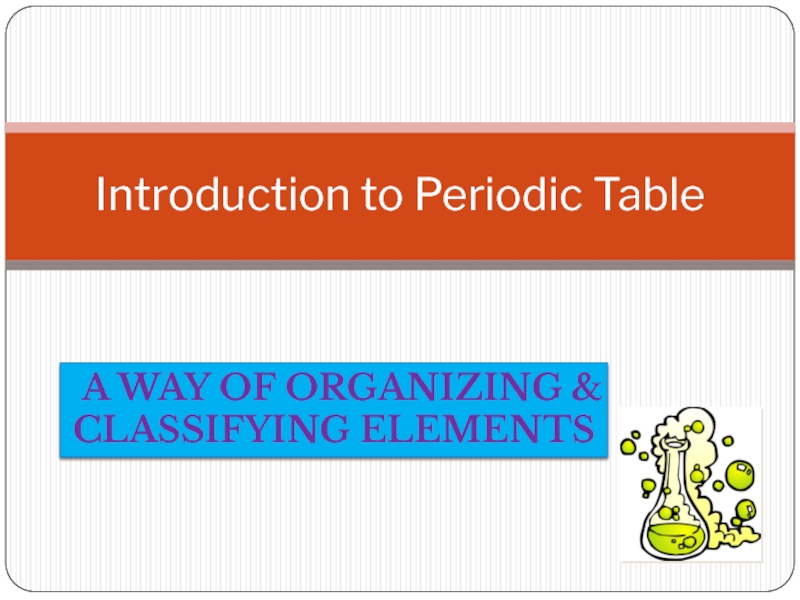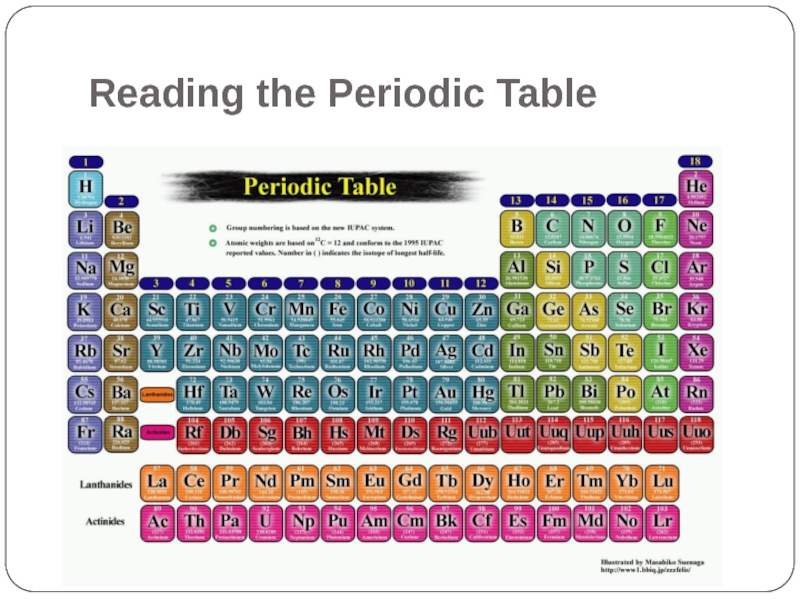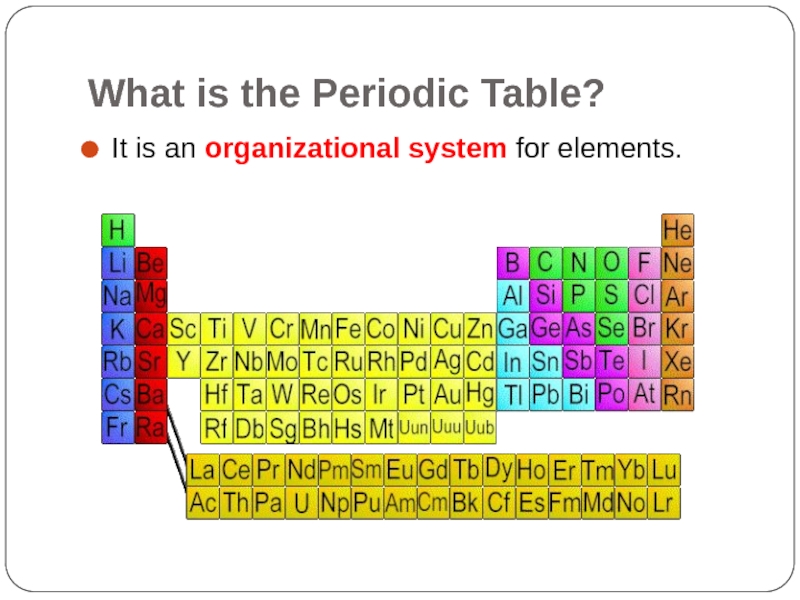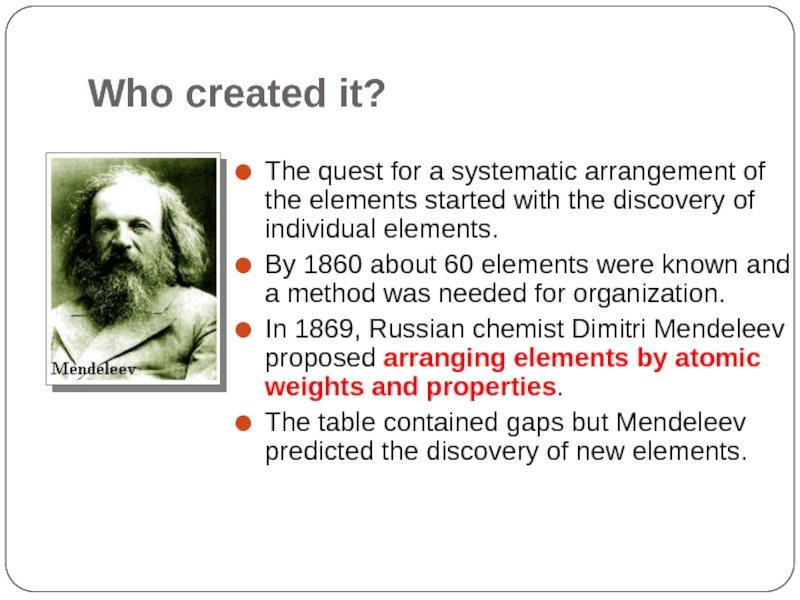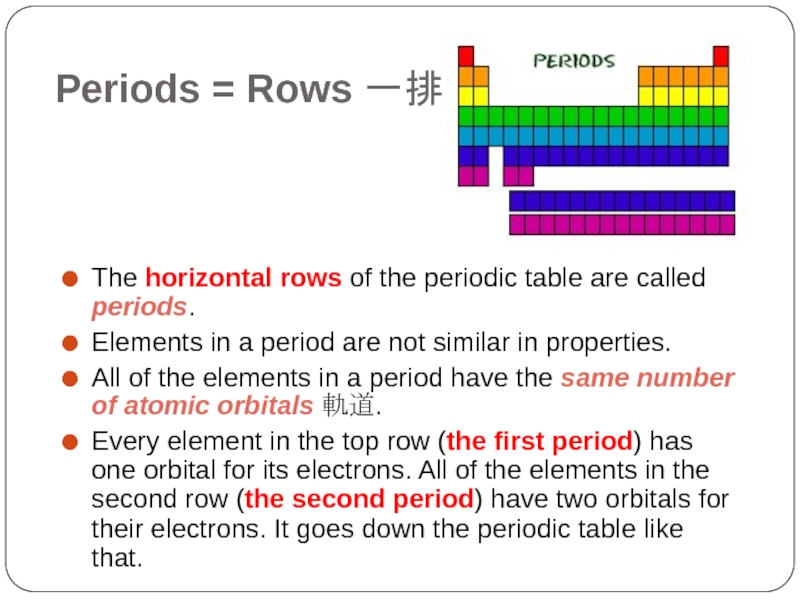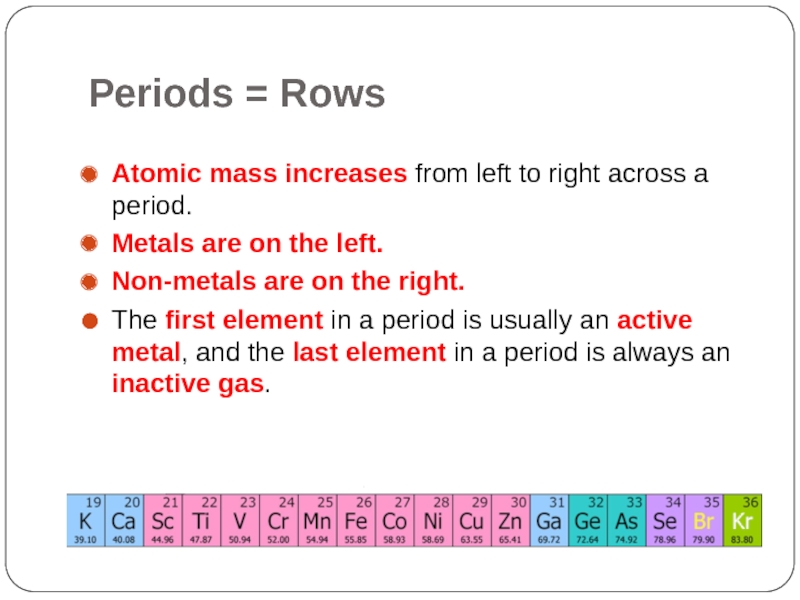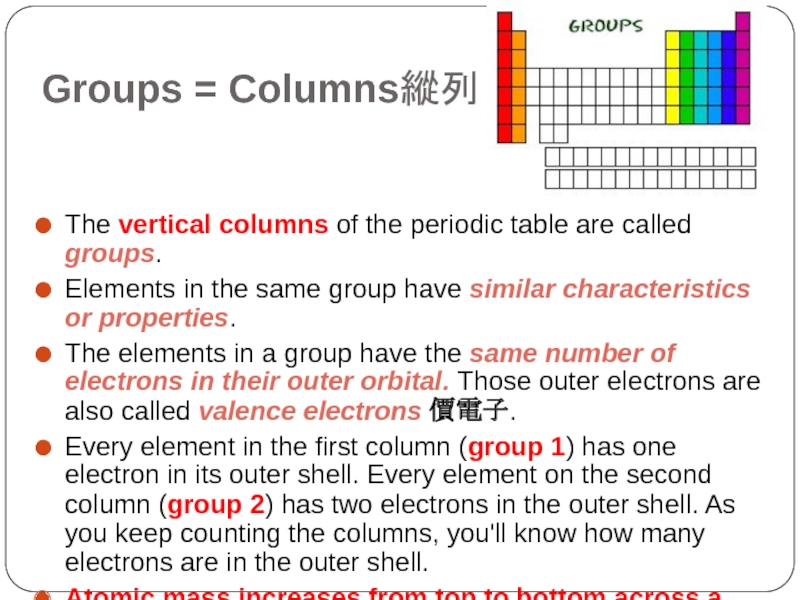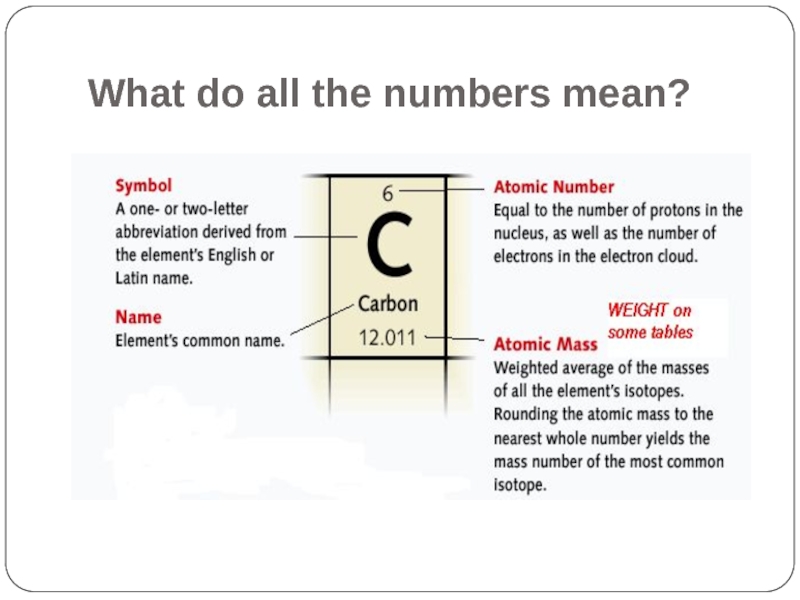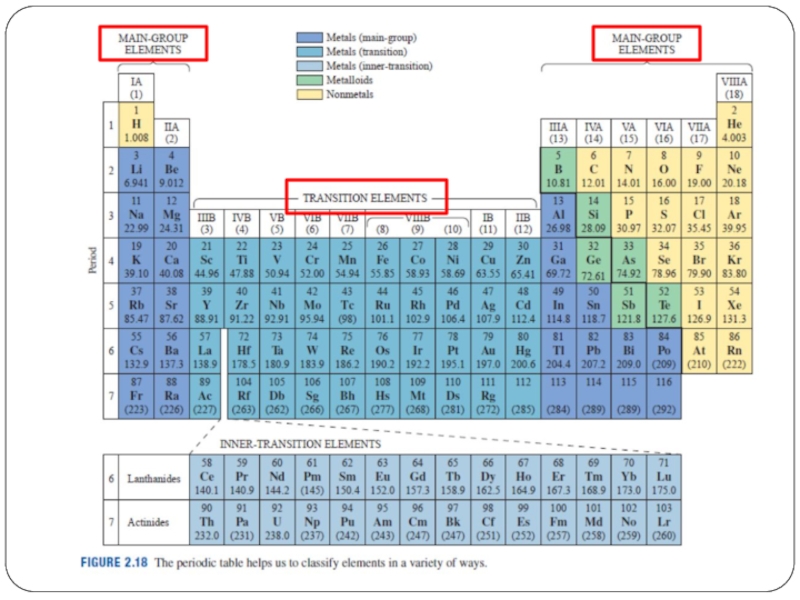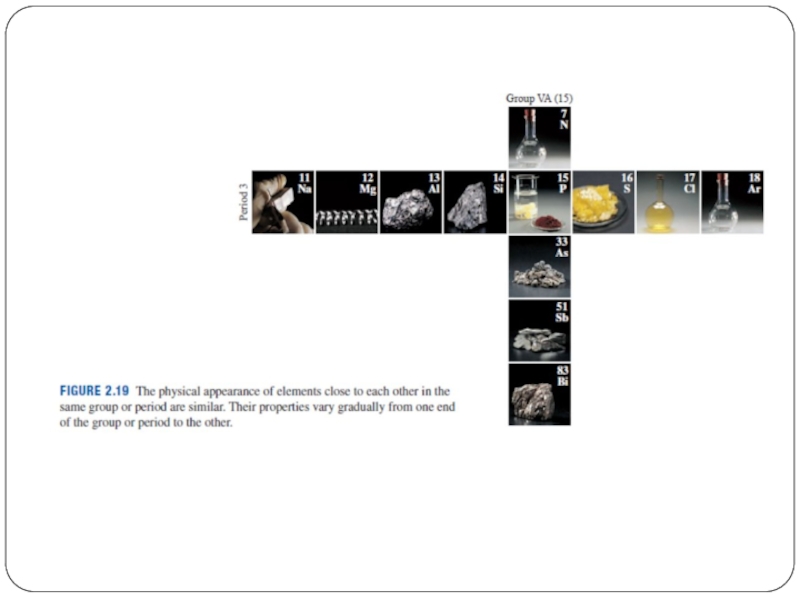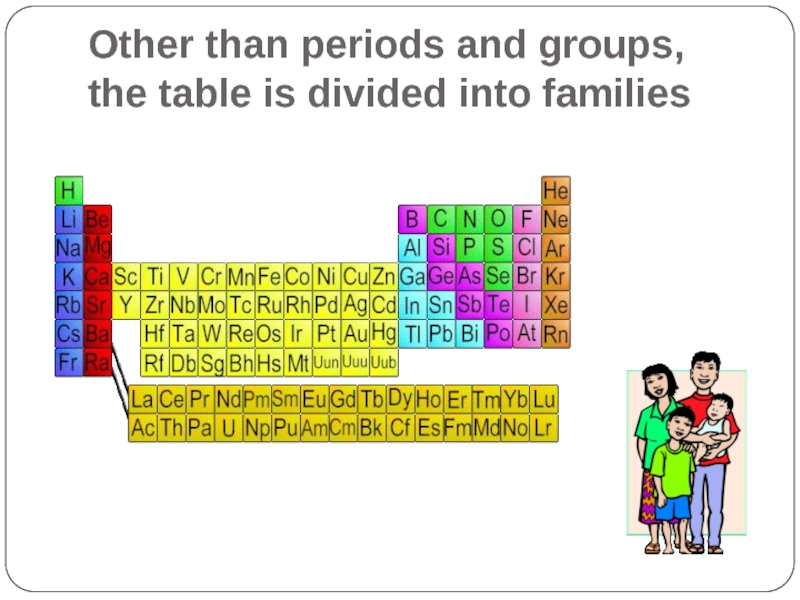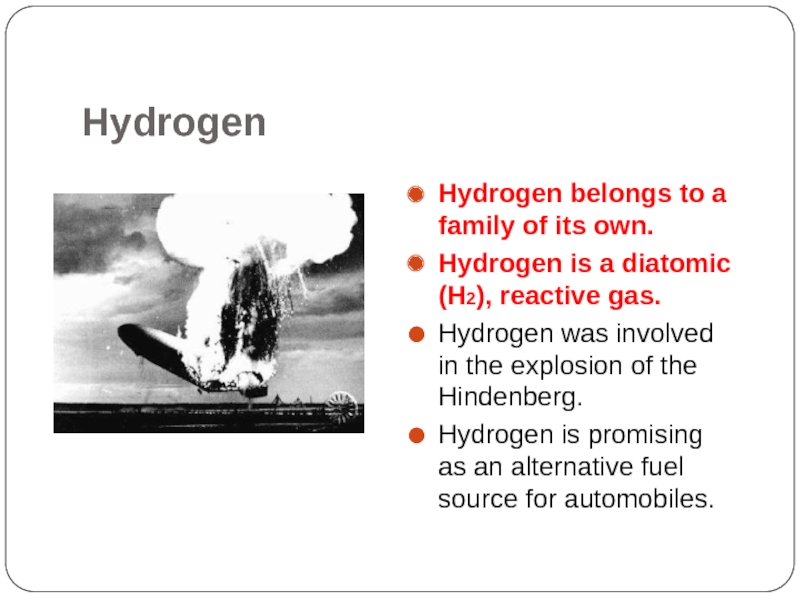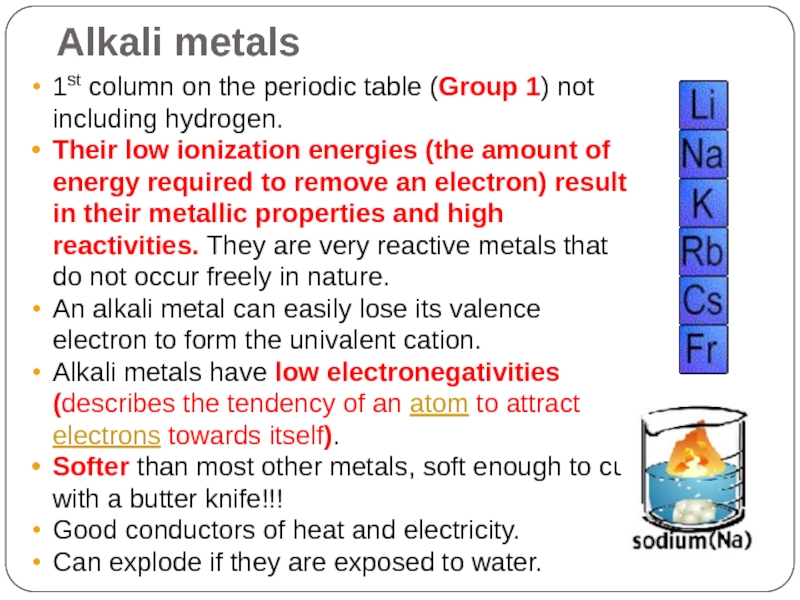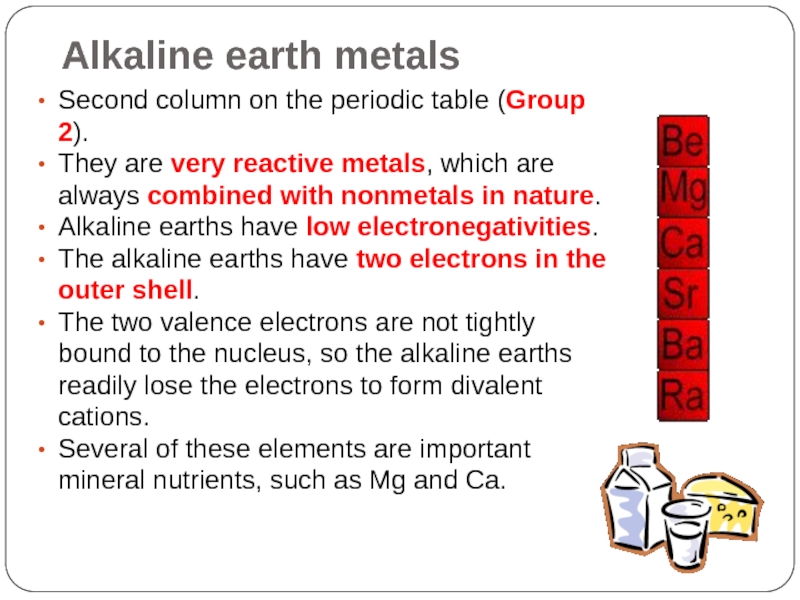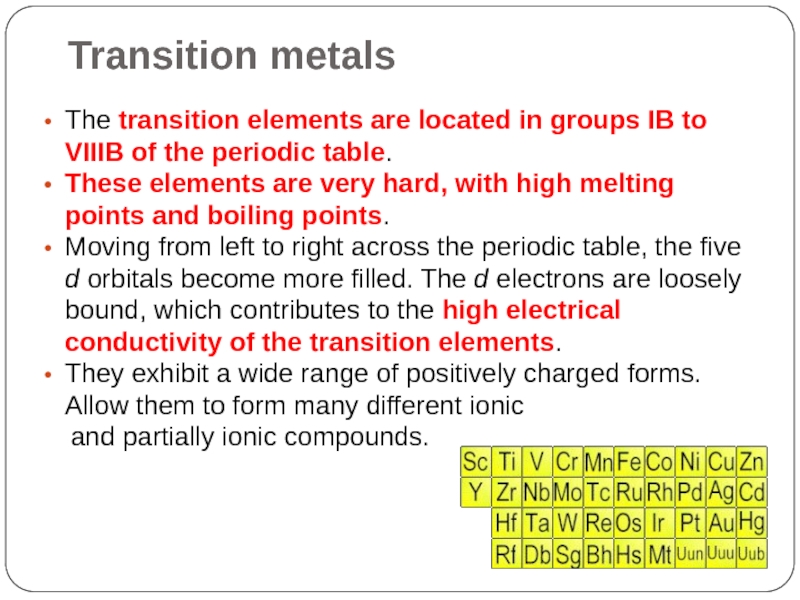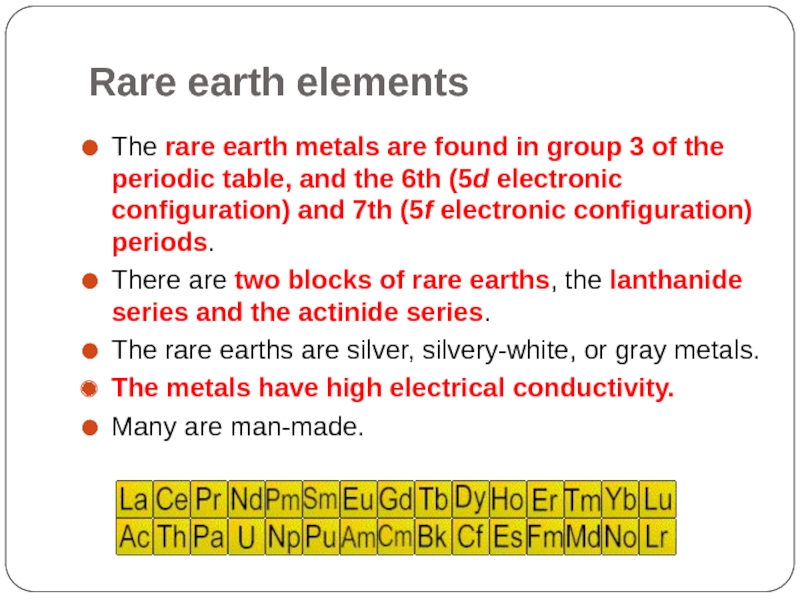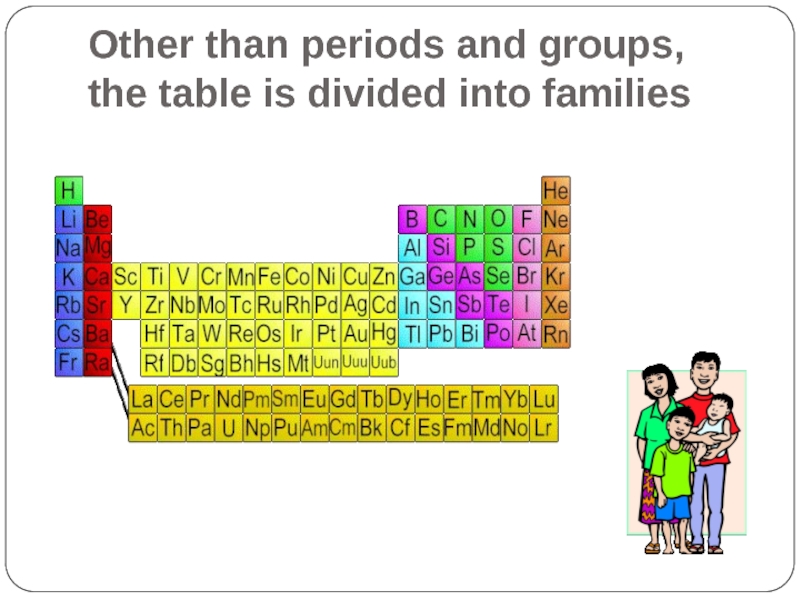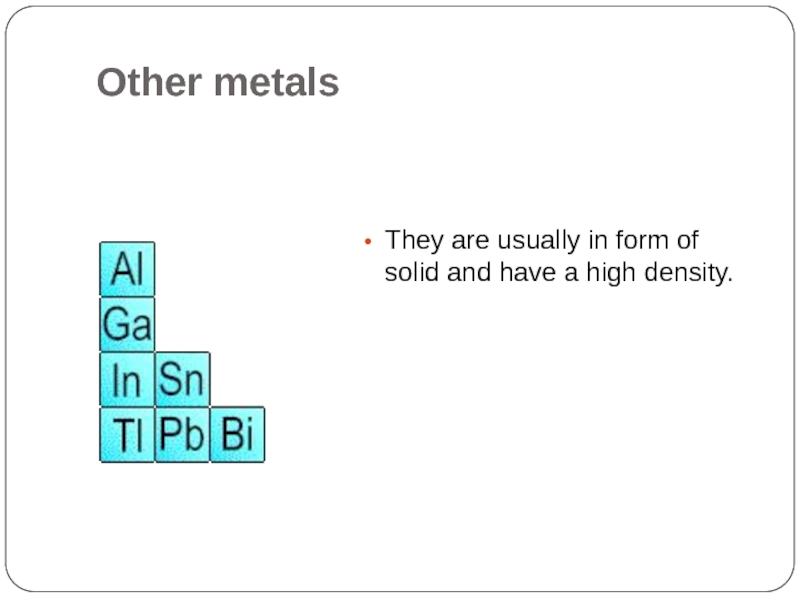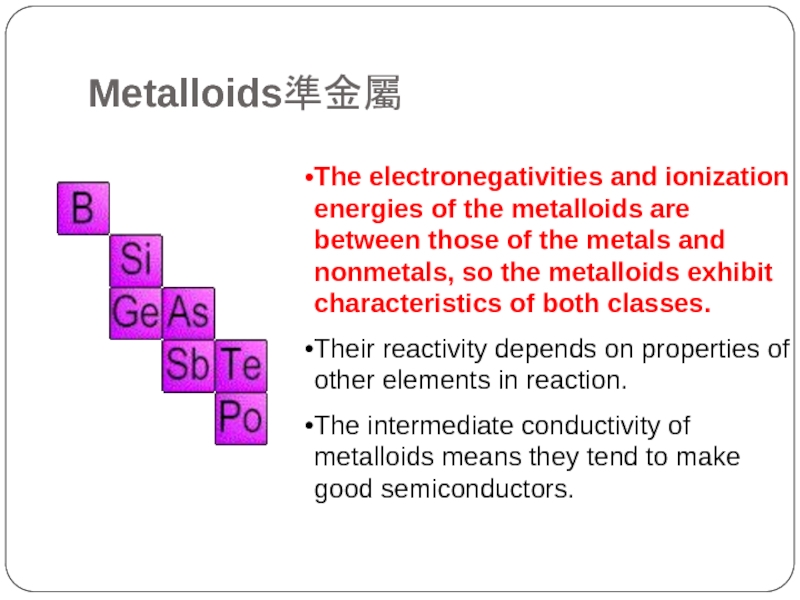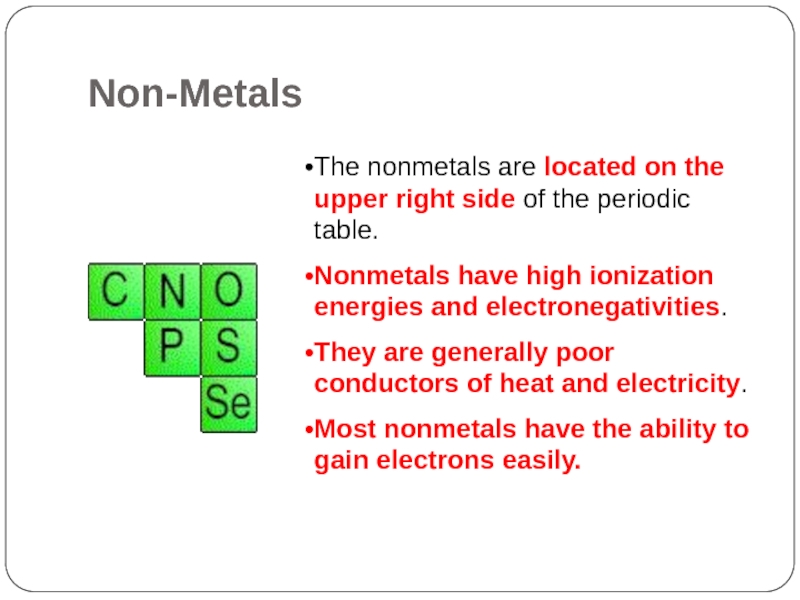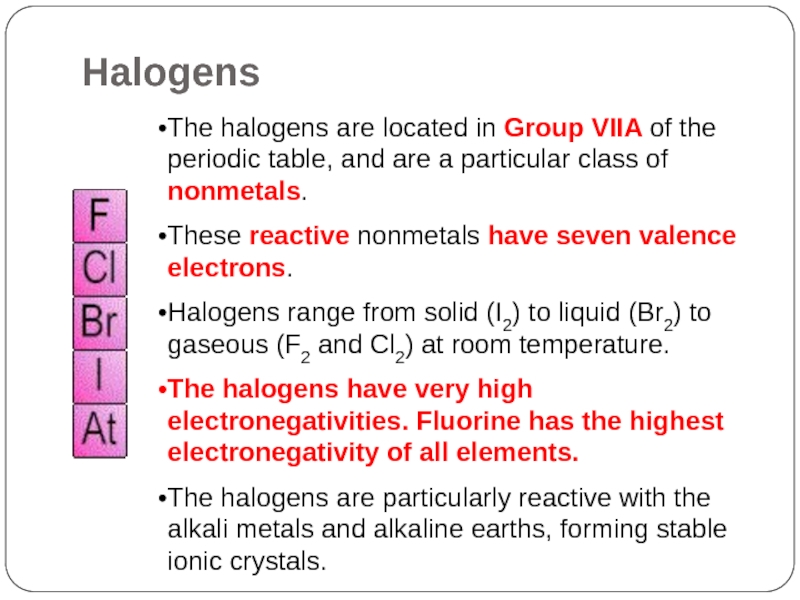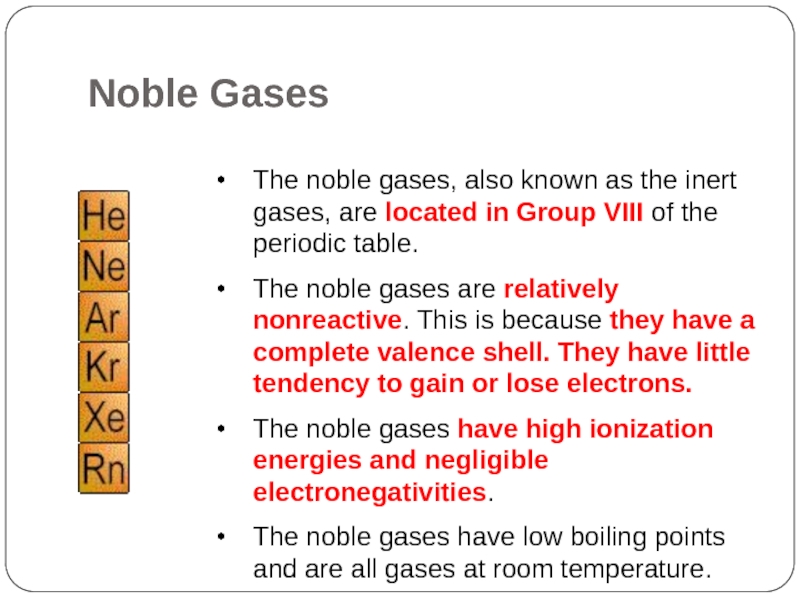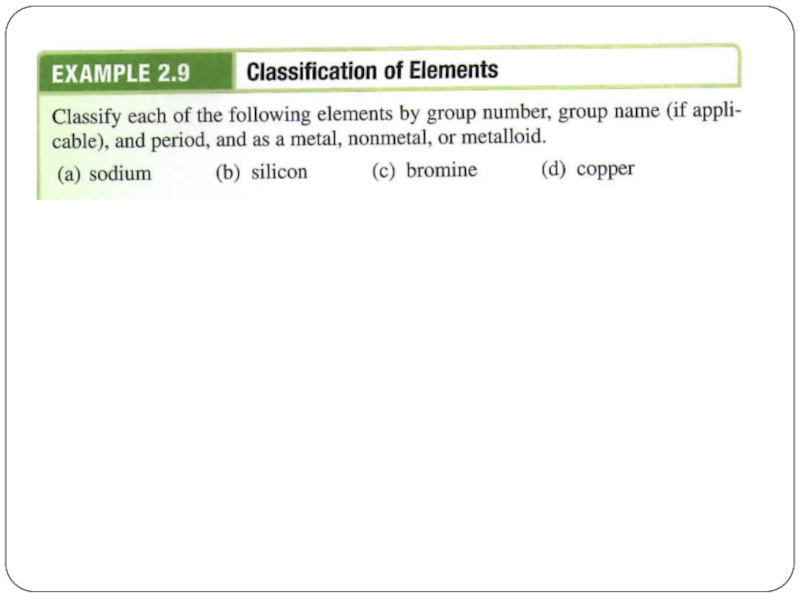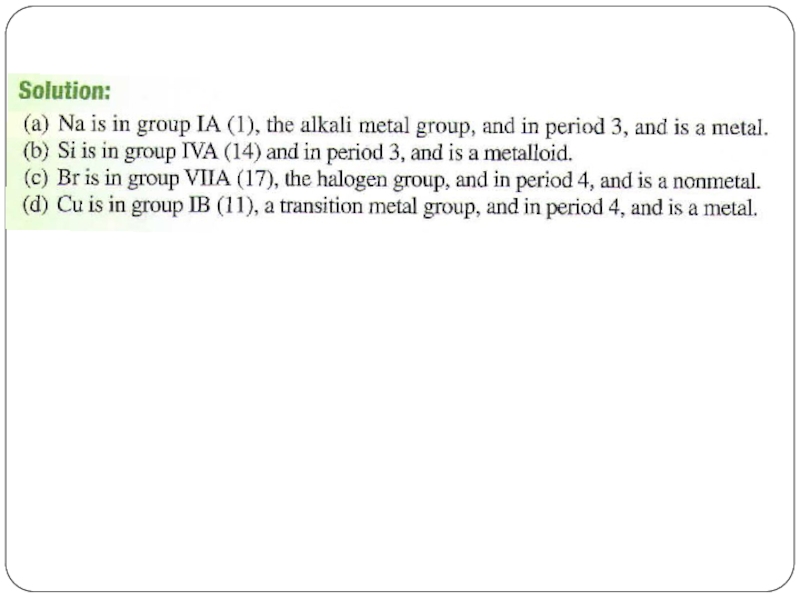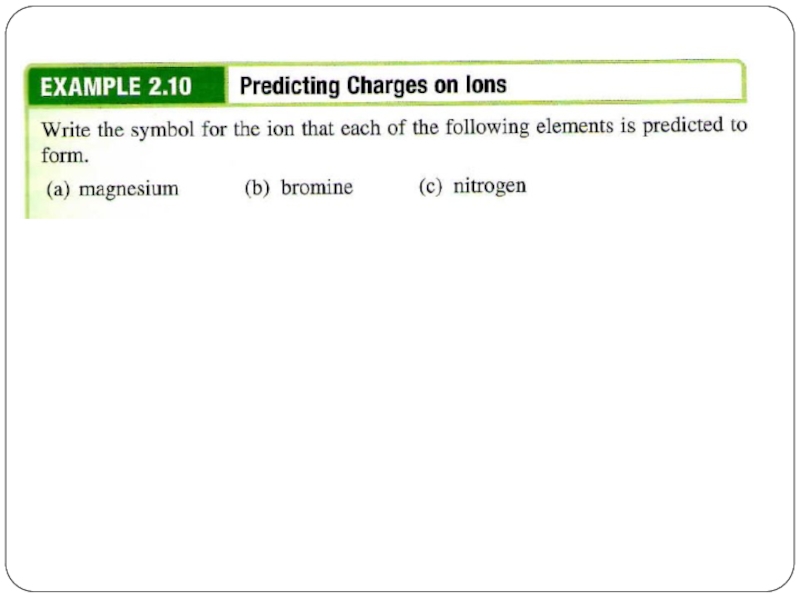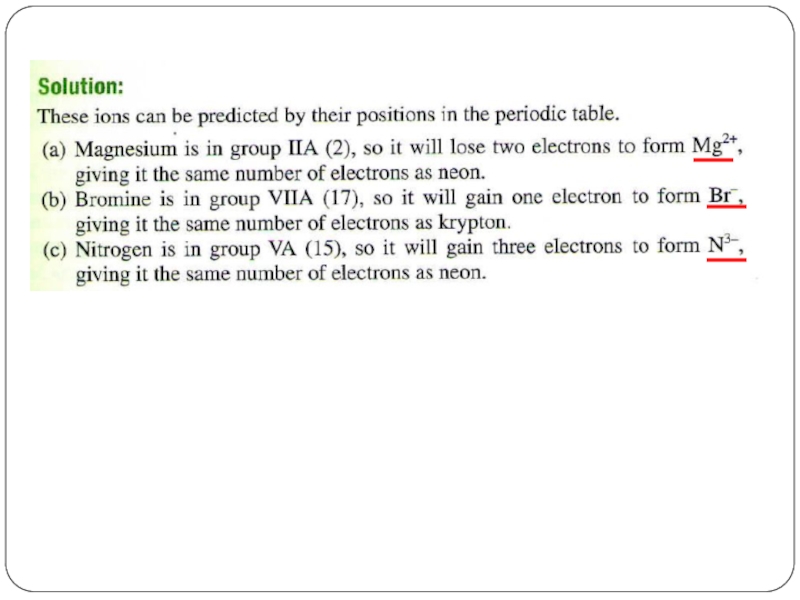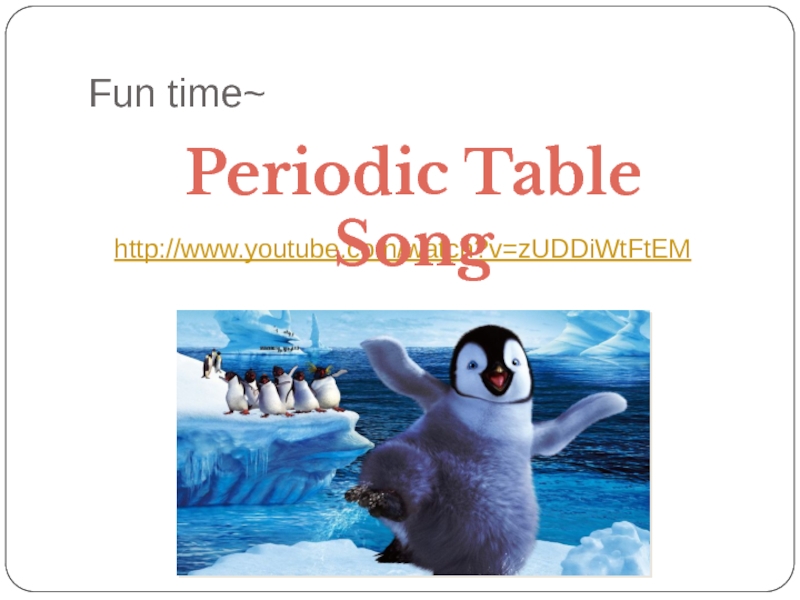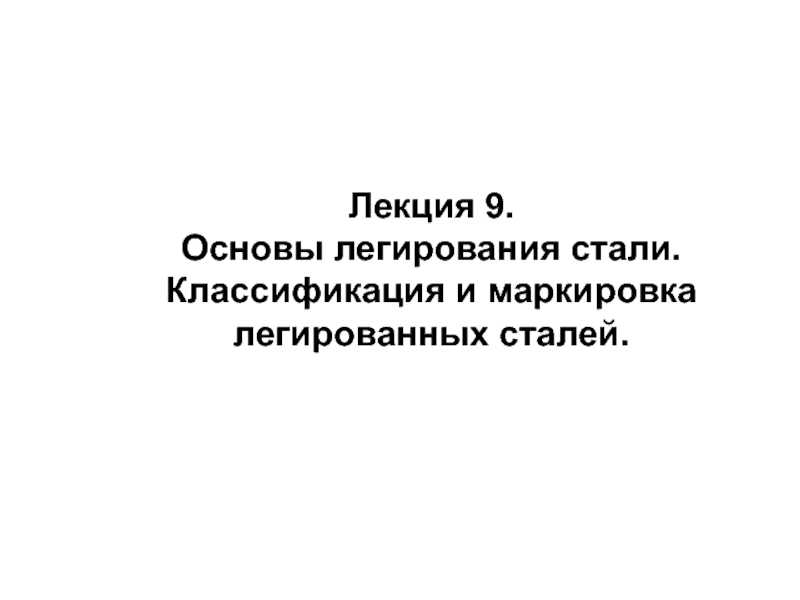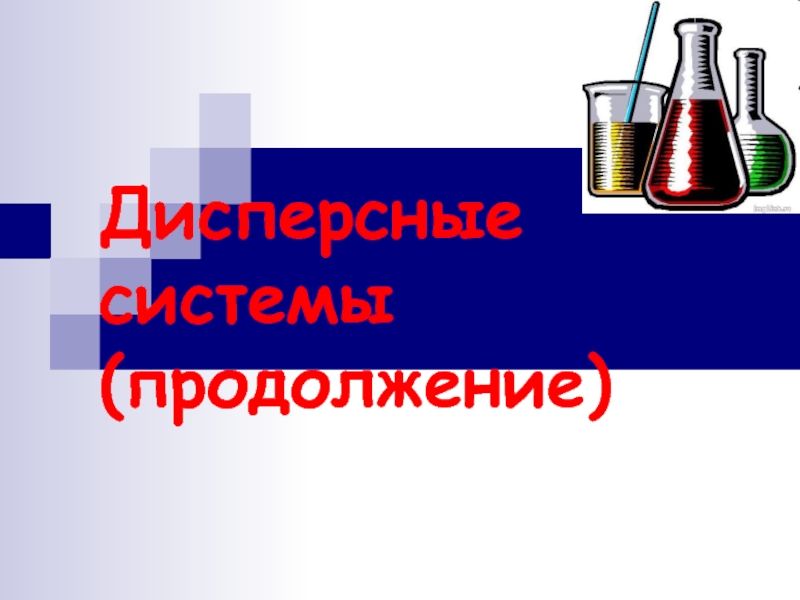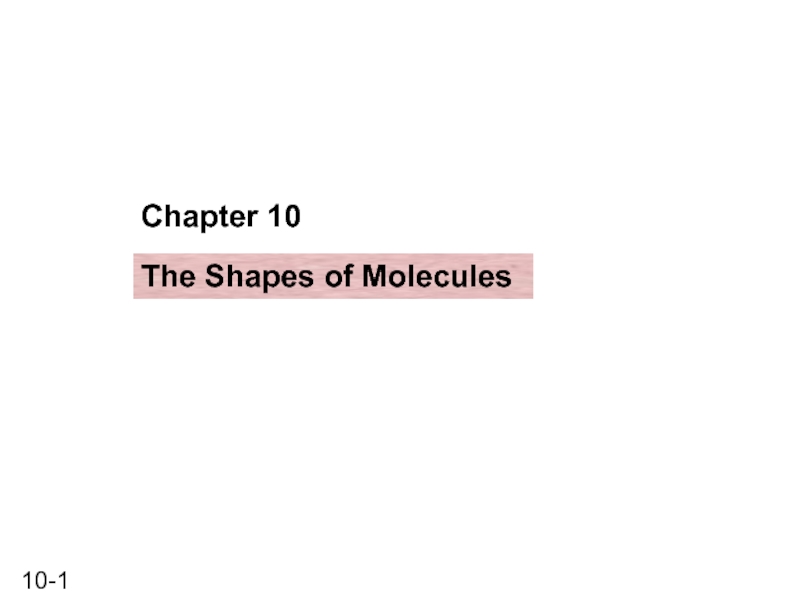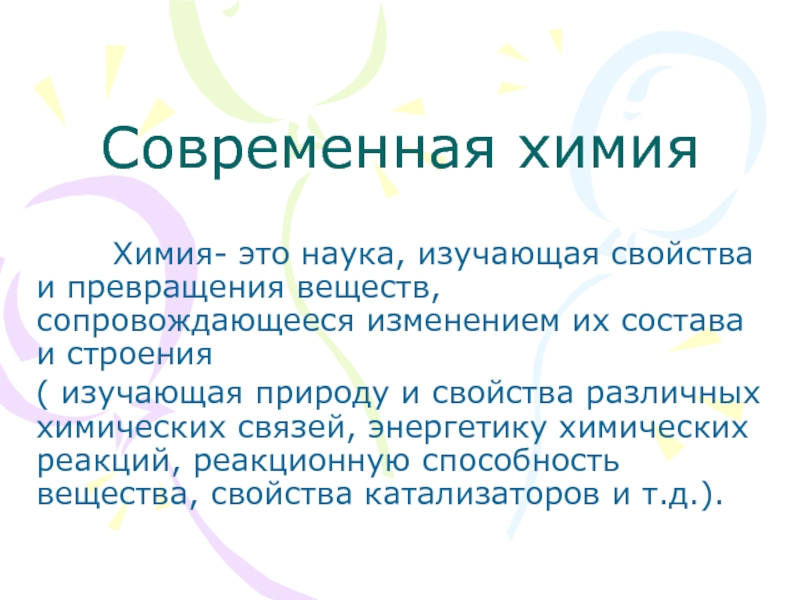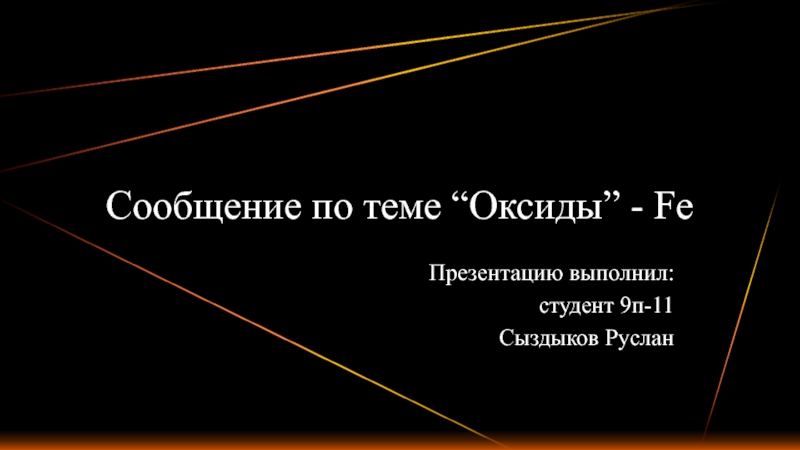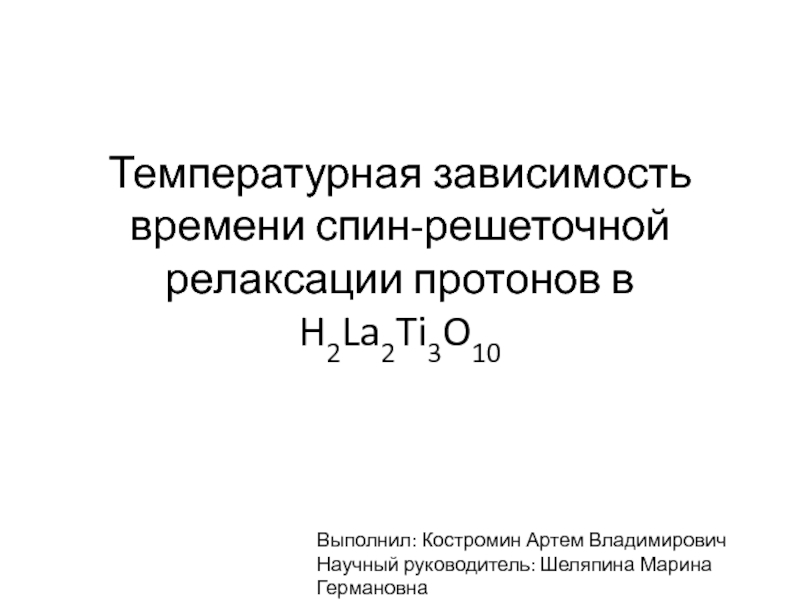- Главная
- Разное
- Дизайн
- Бизнес и предпринимательство
- Аналитика
- Образование
- Развлечения
- Красота и здоровье
- Финансы
- Государство
- Путешествия
- Спорт
- Недвижимость
- Армия
- Графика
- Культурология
- Еда и кулинария
- Лингвистика
- Английский язык
- Астрономия
- Алгебра
- Биология
- География
- Детские презентации
- Информатика
- История
- Литература
- Маркетинг
- Математика
- Медицина
- Менеджмент
- Музыка
- МХК
- Немецкий язык
- ОБЖ
- Обществознание
- Окружающий мир
- Педагогика
- Русский язык
- Технология
- Физика
- Философия
- Химия
- Шаблоны, картинки для презентаций
- Экология
- Экономика
- Юриспруденция
Introduction to Periodic Table презентация
Содержание
- 1. Introduction to Periodic Table
- 2. Reading the Periodic Table
- 3. What is the Periodic Table? It is an organizational system for elements.
- 4. Who created it? The quest for a
- 5. Periods = Rows 一排 The horizontal rows
- 6. Periods = Rows Atomic mass increases
- 7. Groups = Columns縱列 The vertical columns of
- 8. What do all the numbers mean?
- 11. Other than periods and groups, the table is divided into families
- 12. Hydrogen Hydrogen belongs to a family of
- 13. Alkali metals 1st column on the periodic
- 14. Alkaline earth metals Second column on the
- 15. Transition metals The transition elements are located
- 16. Rare earth elements The rare earth metals
- 17. Other than periods and groups, the table is divided into families
- 18. Other metals They are usually in form of solid and have a high density.
- 19. The electronegativities and ionization energies of the
- 20. The nonmetals are located on the upper
- 21. The halogens are located in Group VIIA
- 22. The noble gases, also known as the
- 27. Fun time~ http://www.youtube.com/watch?v=zUDDiWtFtEM Periodic Table Song
Слайд 4Who created it?
The quest for a systematic arrangement of the elements
started with the discovery of individual elements.
By 1860 about 60 elements were known and a method was needed for organization.
In 1869, Russian chemist Dimitri Mendeleev proposed arranging elements by atomic weights and properties.
The table contained gaps but Mendeleev predicted the discovery of new elements.
By 1860 about 60 elements were known and a method was needed for organization.
In 1869, Russian chemist Dimitri Mendeleev proposed arranging elements by atomic weights and properties.
The table contained gaps but Mendeleev predicted the discovery of new elements.
Слайд 5Periods = Rows 一排
The horizontal rows of the periodic table are
called periods.
Elements in a period are not similar in properties.
All of the elements in a period have the same number of atomic orbitals 軌道.
Every element in the top row (the first period) has one orbital for its electrons. All of the elements in the second row (the second period) have two orbitals for their electrons. It goes down the periodic table like that.
Elements in a period are not similar in properties.
All of the elements in a period have the same number of atomic orbitals 軌道.
Every element in the top row (the first period) has one orbital for its electrons. All of the elements in the second row (the second period) have two orbitals for their electrons. It goes down the periodic table like that.
Слайд 6Periods = Rows
Atomic mass increases from left to right across
a period.
Metals are on the left.
Non-metals are on the right.
The first element in a period is usually an active metal, and the last element in a period is always an inactive gas.
Metals are on the left.
Non-metals are on the right.
The first element in a period is usually an active metal, and the last element in a period is always an inactive gas.
Слайд 7Groups = Columns縱列
The vertical columns of the periodic table are called
groups.
Elements in the same group have similar characteristics or properties.
The elements in a group have the same number of electrons in their outer orbital. Those outer electrons are also called valence electrons 價電子.
Every element in the first column (group 1) has one electron in its outer shell. Every element on the second column (group 2) has two electrons in the outer shell. As you keep counting the columns, you'll know how many electrons are in the outer shell.
Atomic mass increases from top to bottom across a group.
Elements in the same group have similar characteristics or properties.
The elements in a group have the same number of electrons in their outer orbital. Those outer electrons are also called valence electrons 價電子.
Every element in the first column (group 1) has one electron in its outer shell. Every element on the second column (group 2) has two electrons in the outer shell. As you keep counting the columns, you'll know how many electrons are in the outer shell.
Atomic mass increases from top to bottom across a group.
Слайд 12Hydrogen
Hydrogen belongs to a family of its own.
Hydrogen is a diatomic
(H2), reactive gas.
Hydrogen was involved in the explosion of the Hindenberg.
Hydrogen is promising as an alternative fuel source for automobiles.
Hydrogen was involved in the explosion of the Hindenberg.
Hydrogen is promising as an alternative fuel source for automobiles.
Слайд 13Alkali metals
1st column on the periodic table (Group 1) not including
hydrogen.
Their low ionization energies (the amount of energy required to remove an electron) result in their metallic properties and high reactivities. They are very reactive metals that do not occur freely in nature.
An alkali metal can easily lose its valence electron to form the univalent cation.
Alkali metals have low electronegativities (describes the tendency of an atom to attract electrons towards itself).
Softer than most other metals, soft enough to cut with a butter knife!!!
Good conductors of heat and electricity.
Can explode if they are exposed to water.
Their low ionization energies (the amount of energy required to remove an electron) result in their metallic properties and high reactivities. They are very reactive metals that do not occur freely in nature.
An alkali metal can easily lose its valence electron to form the univalent cation.
Alkali metals have low electronegativities (describes the tendency of an atom to attract electrons towards itself).
Softer than most other metals, soft enough to cut with a butter knife!!!
Good conductors of heat and electricity.
Can explode if they are exposed to water.
Слайд 14Alkaline earth metals
Second column on the periodic table (Group 2).
They
are very reactive metals, which are always combined with nonmetals in nature.
Alkaline earths have low electronegativities.
The alkaline earths have two electrons in the outer shell.
The two valence electrons are not tightly bound to the nucleus, so the alkaline earths readily lose the electrons to form divalent cations.
Several of these elements are important mineral nutrients, such as Mg and Ca.
Alkaline earths have low electronegativities.
The alkaline earths have two electrons in the outer shell.
The two valence electrons are not tightly bound to the nucleus, so the alkaline earths readily lose the electrons to form divalent cations.
Several of these elements are important mineral nutrients, such as Mg and Ca.
Слайд 15Transition metals
The transition elements are located in groups IB to VIIIB
of the periodic table.
These elements are very hard, with high melting points and boiling points.
Moving from left to right across the periodic table, the five d orbitals become more filled. The d electrons are loosely bound, which contributes to the high electrical conductivity of the transition elements.
They exhibit a wide range of positively charged forms. Allow them to form many different ionic
and partially ionic compounds.
These elements are very hard, with high melting points and boiling points.
Moving from left to right across the periodic table, the five d orbitals become more filled. The d electrons are loosely bound, which contributes to the high electrical conductivity of the transition elements.
They exhibit a wide range of positively charged forms. Allow them to form many different ionic
and partially ionic compounds.
Слайд 16Rare earth elements
The rare earth metals are found in group 3
of the periodic table, and the 6th (5d electronic configuration) and 7th (5f electronic configuration) periods.
There are two blocks of rare earths, the lanthanide series and the actinide series.
The rare earths are silver, silvery-white, or gray metals.
The metals have high electrical conductivity.
Many are man-made.
There are two blocks of rare earths, the lanthanide series and the actinide series.
The rare earths are silver, silvery-white, or gray metals.
The metals have high electrical conductivity.
Many are man-made.
Слайд 19The electronegativities and ionization energies of the metalloids are between those
of the metals and nonmetals, so the metalloids exhibit characteristics of both classes.
Their reactivity depends on properties of other elements in reaction.
The intermediate conductivity of metalloids means they tend to make good semiconductors.
Their reactivity depends on properties of other elements in reaction.
The intermediate conductivity of metalloids means they tend to make good semiconductors.
Metalloids準金屬
Слайд 20The nonmetals are located on the upper right side of the
periodic table.
Nonmetals have high ionization energies and electronegativities.
They are generally poor conductors of heat and electricity.
Most nonmetals have the ability to gain electrons easily.
Nonmetals have high ionization energies and electronegativities.
They are generally poor conductors of heat and electricity.
Most nonmetals have the ability to gain electrons easily.
Non-Metals
Слайд 21The halogens are located in Group VIIA of the periodic table,
and are a particular class of nonmetals.
These reactive nonmetals have seven valence electrons.
Halogens range from solid (I2) to liquid (Br2) to gaseous (F2 and Cl2) at room temperature.
The halogens have very high electronegativities. Fluorine has the highest electronegativity of all elements.
The halogens are particularly reactive with the alkali metals and alkaline earths, forming stable ionic crystals.
These reactive nonmetals have seven valence electrons.
Halogens range from solid (I2) to liquid (Br2) to gaseous (F2 and Cl2) at room temperature.
The halogens have very high electronegativities. Fluorine has the highest electronegativity of all elements.
The halogens are particularly reactive with the alkali metals and alkaline earths, forming stable ionic crystals.
Halogens
Слайд 22The noble gases, also known as the inert gases, are located
in Group VIII of the periodic table.
The noble gases are relatively nonreactive. This is because they have a complete valence shell. They have little tendency to gain or lose electrons.
The noble gases have high ionization energies and negligible electronegativities.
The noble gases have low boiling points and are all gases at room temperature.
The noble gases are relatively nonreactive. This is because they have a complete valence shell. They have little tendency to gain or lose electrons.
The noble gases have high ionization energies and negligible electronegativities.
The noble gases have low boiling points and are all gases at room temperature.
Noble Gases
